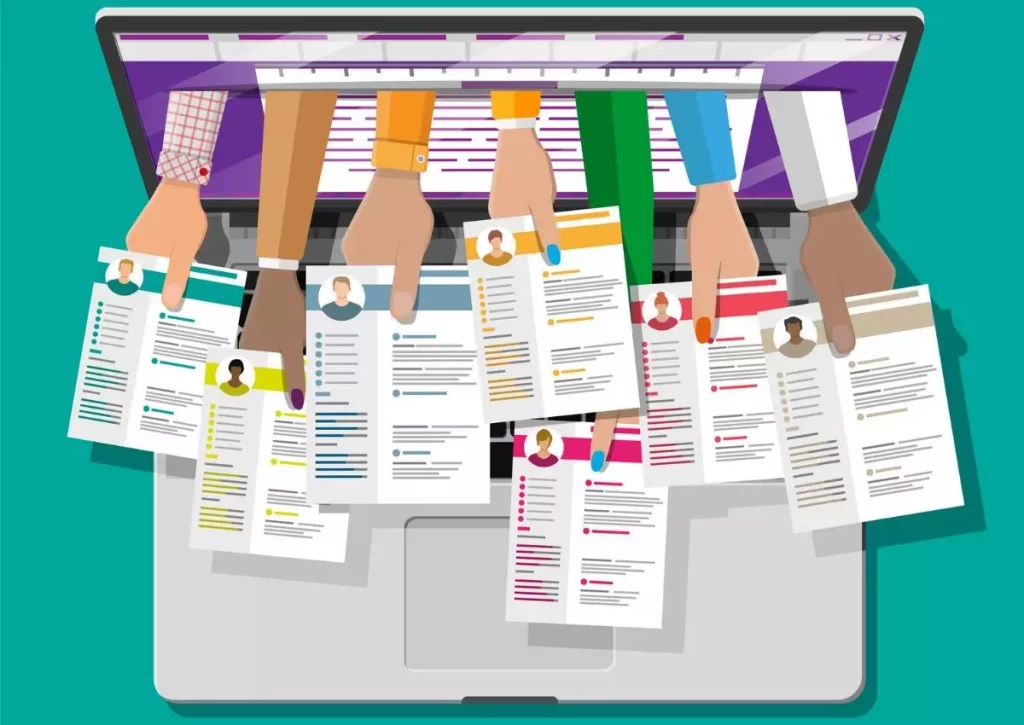Bias, even if unconscious, can have a negative impact on the hiring process. The preconceived notions and ideas of recruiters and hiring managers can be detrimental to the company. It can affect shortlisting applicants, conducting interviews, and making hiring decisions. This creates an unfair playing field for candidates—and causes your organization to miss out on some excellent potential new hires.
Companies of all sizes are removing bias from their hiring processes by implementing blind hiring practices to ensure they bring on the best talent.
Blind hiring is when a company doesn’t consider an applicant’s name, age, gender, race, or ethnicity during the interview process. Instead, they focus on what the applicant can bring skill-wise.
Is blind hiring an excellent way to find qualified employees? Or does it have some major drawbacks? Let’s examine the pros and cons of blind hiring and its statistics.
What is blind hiring?
Blind hiring is a hiring tactic that eliminates biases during talent acquisition by removing details such as name, gender, religion, or socioeconomic background. It also removes academic qualifications. Ultimately, candidates are judged on their skills rather than where they came from, what they believe in, or what they look like.

In theory, companies can ensure they are selecting the best candidates by removing the factors that could lead to a biased hire.
There are many reasons why an employer may choose to implement blind hiring. One reason is to level the playing field for all applicants, regardless of their background or credentials. This can help to ensure that only the most qualified candidates are hired for the job so it may benefit the company.
Additionally, blind hiring can help to create a more diverse workforce. By not considering factors such as age, gender, or race when making hiring decisions, employers can create a workforce that is more representative of the population as a whole.
Pros and cons of blind hiring
Blind hiring is seen as a way to reduce bias in the hiring process. It has been growing in popularity in recent years. However, some pros and cons to blind hiring should be considered.
|
The Pros of Blind Hiring |
The Cons of Blind Hiring |
| Recruiters or hiring managers will not be able to screen for candidates who look like them, so blind hiring can promote greater diversity in the workplace.
|
Blind hiring can sometimes reduce hiring diversity. Many organizations seek out minority candidates during the hiring process. When recruiters are unable to access personal information, they have difficulty hiring diverse candidates. |
|
Blind hiring is considered more “scientific” because each candidate receives the same assessments. During the preliminary telephone interview, interviewers may ask candidates questions based on biases that emerge during the conversations. As a result, the interview process loses objectivity. The hiring manager makes a subconscious decision based on personal biases as the interviewee reveals personal information. All of this happens before the hiring manager makes her final choice for face-to-face interviews. |
Blind hiring ignores the need to find a “cultural” fit between a candidate and an organization. Knowing which organizations a candidate has previously worked for can provide useful information about the type of work environment in which a candidate has thrived. |
|
Blind hiring eliminates the “who do you know” practice that many hiring managers employ and instead broadens the field to include candidates with higher skill levels. | Blind hiring has the potential to eliminate the widely used practice of referrals. Many managers and executives announce that they are looking for someone to fill a position within their networking groups. They give more importance to the referrals from colleagues, and hire them. |
Essential techniques of blind hiring
An employer can do certain things to make sure that the hiring process is as fair as possible. One way is to use blind hiring techniques. This means removing all identifying information from resumes and applications, such as names, addresses, and contact information.

Here are four essential techniques for blind hiring:
- Use a third-party screening service
- Remove identifying information from resumes and applications.
- Use a software program to select candidates for interviews randomly.
- You can have someone else conduct the interviews.
With these techniques, you can help ensure that your hiring process is fair and unbiased. So how to implement one of these techniques specifically? Let’s dive into the steps to make it happen.
Maybe you should know:
- Best Steps To Hiring And Retaining An Employee
- Essential Hiring Tips For Small Business And Ways To Retain Talents
Best steps for efficient blind recruitment
By removing any visual elements from the application process, you can open up opportunities to some of the best and brightest candidates who may not have been considered otherwise.
Here are a few steps to start your blind recruitment process.
Step 1: Blind job applications
Attracting diverse candidates is the first step in a blind hiring process. This entails writing job descriptions that are inclusive and gender-neutral to attract a diverse range of applicants without any hidden biases. According to research, listings with gender-neutral wording can generate 42% more responses.

Locate a recruiting software platform or tool that can collect resumes and CVs while removing any personally identifiable information. You can also have a team member not involved in the hiring process anonymously mark each application.
This individual can extract relevant information such as work experience, skills, and certifications while removing any data that could lead to unconscious bias.
Step 2: Blind candidate’s screening process
You can begin your screening process once you have a database of applicants. Many businesses find that requiring a skill test at this stage is beneficial. Skill assessments level the playing field by allowing candidates to demonstrate their abilities in a controlled environment.
Platforms offer immersive environments in which candidates respond to various question types, such as media, software, and multiple-choice, that simulate the tasks they would perform in your company if hired.
The AI then ranks a list of candidates in order of performance for the most important skills, saving recruiters’ time from manually reviewing resumes or backgrounds. Furthermore, because no personally identifying information is used in the process, it’s fair to all candidates, improving diversity, equality, and inclusion on a recruiter’s shortlist.
This type of screening is far more effective than other methods, such as checking a candidate’s social media profiles.
Step 3: Blind interview
In a blind interview the candidate’s identity is concealed throughout the interview. This can be done through technology by changing the interview format so that it is neither live nor in-person.
Chat tools can help keep the interview anonymous, and sending the candidate an anonymously written Q&A is another option. Chatbots are also gaining popularity as a way to conduct anonymous interviews and automate one of the more time-consuming steps in the hiring process.
Many of these strategies are also appropriate for companies hiring remotely to broaden their candidate outreach to different time zones.
Conclusion
Blind hiring is a useful process that has the potential to change the way we recruit employees. It levels the playing field for job seekers and can help organizations identify hidden talents.
However, blind hiring also has its drawbacks, such as the potential for unconscious bias, or recruiting a candidate that is not a good fit for your company. It is still undetermined whether blind hiring is effective or not. Still, it’s something worth considering if you’re looking for new ways to improve your recruiting process. Have you tried blind hiring? What were your results?
References
- Department of Education and Training. (2020). Best Practice Guide Recruitment and Selection. Melbourne: Department of Education and Training. Retrieved from https://www.education.vic.gov.au/hrweb/Documents/Best-Practice-Guide-Recruitment-Selection.pdf
- Manikandan.S. (2020). A Modern Concept of Blind Hiring: Its Importance and Benefits. Haryana: IOSR. Retrieved from https://www.iosrjournals.org/iosr-jbm/papers/Vol22-issue5/Series-1/G2205016062.pdf
- Ulf Rinne. (2022). Anonymous job applications and hiring discrimination. Econstor. Retrieved from https://www.econstor.eu/bitstream/10419/193416/1/iza-wol-048v2.pdf

